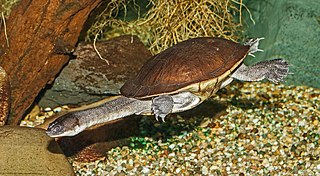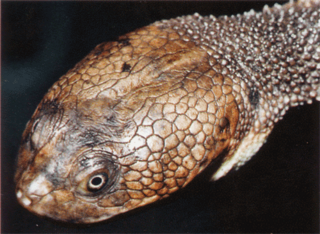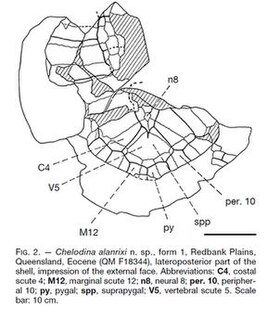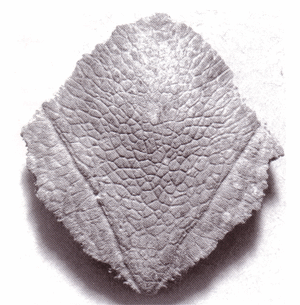
Chelidae is one of three living families of the turtle/tortoise suborder Pleurodira, and are commonly called Austro-South American side-neck turtles. The family is distributed in Australia, New Guinea, parts of Indonesia, and throughout most of South America. It is a large family of turtles with a significant fossil history dating back to the Cretaceous. The family is entirely Gondwanan in origin, with no members found outside Gondwana, either in the present day or as a fossil.

The eastern long-necked turtle is an east Australian species of snake-necked turtle that inhabits a wide variety of water bodies and is an opportunistic feeder. It is a side-necked turtle (Pleurodira), meaning that it bends its head sideways into its shell rather than pulling it directly back.

Chelodina, collectively known as snake-necked turtles, is a large and diverse genus of long-necked chelid turtles with a complicated nomenclatural history. Although in the past, Macrochelodina and Macrodiremys have been considered separate genera and prior to that all the same, they are now considered subgenera of the Chelodina, further Macrochelodina and Macrodiremys are now known to apply to the same species, hence Chelydera is used for the northern Snakeneck Turtles.

The Roti Island snake-necked turtle, also commonly known as McCord's snakeneck turtle, is a critically endangered turtle species from Rote Island in Indonesia.

The Argentine snake-necked turtle, also known commonly as the South American snake-necked turtle is a species of turtle in the family Chelidae. The species is known for the long neck to which its common names refer. Despite appearances, the Argentine snake-necked turtle is probably more closely related to the mata mata than to the Australian snake-necked turtles in the genus Chelodina. H. tectifera is found in northern Argentina, Uruguay, Paraguay, and southern Brazil. Not much is known about it, as it has not been extensively researched. It is a popular pet in the exotic pet trade.

The New Guinea snake-necked turtle is a species of turtle in the family Chelidae. The species is found almost exclusively within Western Province, Papua New Guinea.

The southwestern snake-necked turtle, narrow-breasted snake-necked turtle or oblong turtle is a species of turtle in the family Chelidae. It is endemic to the southwestern part of Western Australia.

Parker's snake-necked turtle is a species of turtle in the family Chelidae.
Pritchard's snake-necked turtle is a species of turtles in the family Chelidae. The species is endemic to a restricted area of Central Province, Papua New Guinea.
Reimann's snake-necked turtle is a species of turtle in the family Chelidae. The species is endemic to Oceania and Southeast Asia.

The northern snake-necked turtle is a species of turtle in the family Chelidae or Austro-South American Side-necked Turtles. It is native to northern Australia and southern New Guinea.

Hydromedusa is a turtle genus in the family Chelidae, commonly known as the South American snake-necked turtles. They are quite closely related to the South American side-necked swamp turtles (Acanthochelys) and the snake-necked turtles of the Australian-Melanesian region (Chelodina), but less closely to the spine-necked river turtles of South America (Podocnemididae) which belong to a more modern lineage of Pleurodira.

Chelodina canni, known as Cann's snake-necked turtle, is an Australian species found in the northern and northeastern parts of the continent. It has a narrow zone of hybridization with its related species the eastern snake-necked turtle, Chelodina longicollis. For many years this species was assumed to be the same species as Chelodina novaeguineae from New Guinea, however recently it has been shown that these two species differ both morphologically and genetically. Hence it was separated and described as a unique species in 2002.

Chelodina (Chelydera) burrungandjii, the sandstone snake-necked turtle, is a medium-sized turtle reaching carapace lengths of 316 mm. The species is found in the sandstone plateaus and escarpments and the plunge pools of Arnhem Land of the Northern Territory. The species had been long recognised as valid. However, it had been difficult to research due to the remoteness of its habitat. Efforts to breed this species in captivity had been largely unsuccessful, until National Aquarium Herpetologist Matthew Benedict lead a successful breeding project in 2021. The species occurs in proximity to Chelodina rugosa, to which it is closely related. For the most part the two species are parapatric in distribution. However, they do come together in limited locations such as plunge pools at the base of the escarpments. In these areas there is hybridization between the species.

Chelodina alanrixi is a species of snake-necked fossil turtle which was described in 2001 using material gathered in Redbank Plains, Queensland, Australia. It is a member of the Chelidae Pleurodira. The fossil has been dated to the Eocene Epoch.
Chelodina murrayi is an extinct species of snake-necked turtle from the Waite Formation on the Alcoota Scientific Reserve, north-east of Alice Springs in the Northern Territory of Australia. The species would appear to belong to the Chelodina novaeguineae group of species within the subgenus Chelodina.

Chelodina insculpta is an extinct species of snake-necked turtle that was described in 1897 from material gathered in Darling Downs, Queensland, Australia, restricted. It is a member of the Chelidae; Pleurodira. The fossil has been dated as Pliocene to Pleistocene.

Undun is a lake on the Indonesian island of Roti in the province of East Nusa Tenggara, in the Lesser Sunda Islands.

Scott A. Thomson is an Australian paleontologist, taxonomist, and herpetologist specialising in turtles of the family Chelidae.
Chelodina gunaleni or Gunalen's snake-necked turtle is a turtle species in the family Chelidae. The species is endemic to the lowlands of west-central West Papua, Indonesia, south of the central ranges.














